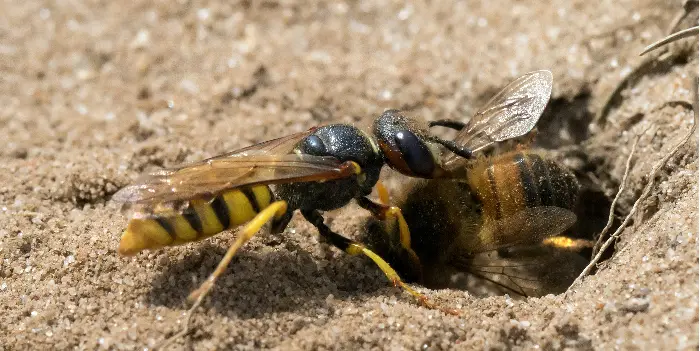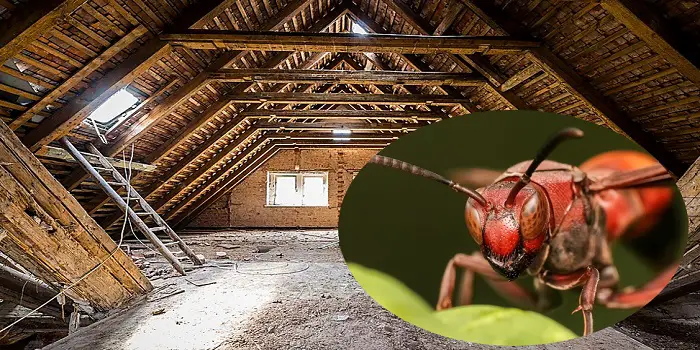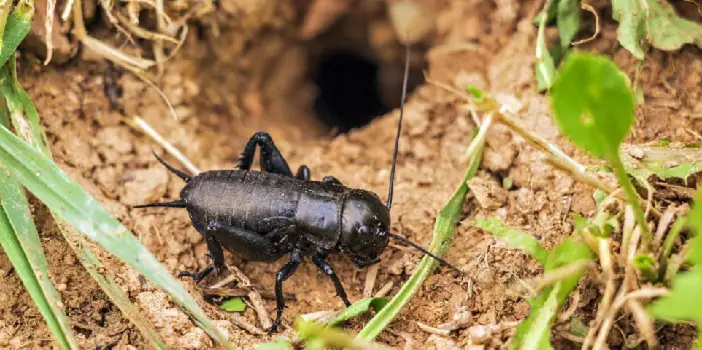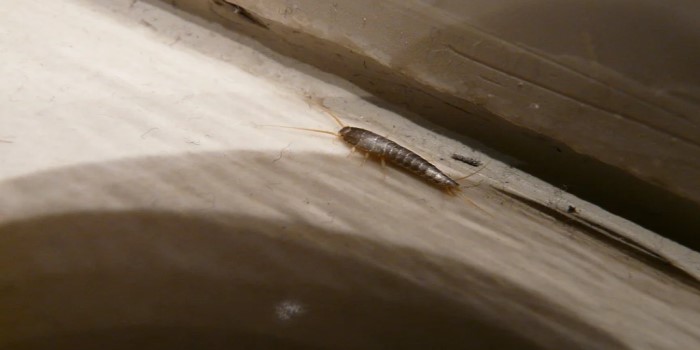
Silverfish in and of themselves are harmless, but they are not desirable in your home.
Their slimy appearance and feasting on starchy materials, particularly the paper in books, means you want them out of your home as soon as possible.
If you find silverfish present in your home, you can take action to get rid of them.
Repelling, trapping, and killing silverfish will reduce their population, but you will need to be careful when using pesticides or poisons inside the home.
Plus, you may have to experiment with different techniques to get rid of them.
What are Silverfish?
Silverfish are insects that are distinguished by their scaly appearance, which somewhat resembles fish – hence their name.
They are about a half-inch long, have two antennae located on their heads, three prongs on the tails, and will wriggle about as they move.
The feature that helps recognize silverfish fast is their color.
The young ones are mostly silver in color, although as they age, the color will turn more grayish to blueish.
While silverfish are often seen around drains, such as in the sink, they normally hide in the closet amid the food sources of their choice.
Silverfish can also breed quite rapidly, with a single pair producing up to 20 eggs per day, with the larvae reaching adulthood in three to four weeks.
Left unchecked, silverfish can overrun your home relatively quickly.
Why are They in Your Closet?
Because silverfish are relatively slow, they prefer dark, damp areas where they can breed.
Since their compound eyes are light-sensitive, you will most likely find them in your home at night.
The closet, in general, has plenty of food sources in the form of starchy materials that they like to feed on, especially if you store books, boxes, clothing, and the like.
This is also because silverfish are attracted to materials that taste like paper, sugar, textiles, glue, or wood, especially wet wood.
One reason you will often also find these long skinny black bugs with wings around the drains is that they enjoy the present moisture.
In addition to the closet and around drains, you will often find them in basements, attics, the laundry room, and especially in places where they can hide.
Outside they may be found in nests built by other insects, birds, or mammals. These are usually located under tree bark, mulch, wood shingles, or sidings.
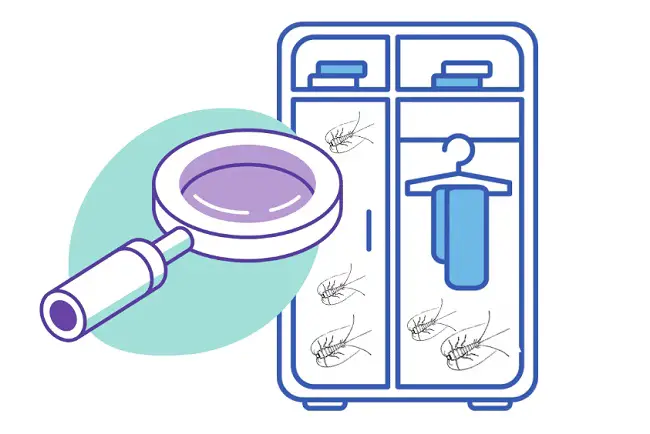
Removing Silverfish from Clothes and Books
The average lifespan of a silverfish is between two and eight years.
They get multiplied fast as females can produce eggs all year at the rate of one to three eggs per day.
This means their population can get uncontrolled soon if left unnoticed.
If they find a way into your closet through voids, they can ruin your expensive cotton or silk clothing along with other fabrics and book bindings.
While pesticides can kill silverfish, they will do more damage than good when trying to remove them from books and your closet.
Instead, you will need to use methods that draw away the silverfish from your desired items.
What follows are a few safe methods and steps that will reduce their population.
1- Inspection
To remove silverfish from your closets, you will need to see where they are precisely located.
Since silverfish are nocturnal, you may have to wait until dark before you can surprise them.
More likely, you will see where they have been as they leave a trail of excrement that appears like black pepper amid the dark, damp areas where they move.
Another indication is their small holes in the paper, cardboard, and wet wood.
In addition, silverfish will shed their skin often, so you may find small casts of their skin left behind.
The bathroom and basement are good places to look.
Keep in mind that silverfish in your home will also find their way to the books and clothes inside the closets as they provide food and cover.
2- Trapping
This is one of the most common ways to get rid of silverfish by providing them with a tasty treat inside a trap.
a) Mason jar
You can make a simple trap by putting some old newspapers inside an open mason jar.
Simply replace the lid once the silverfish are inside and dispose of the insects.
You can also use a mason jar with bread as bait and masking tape to make it easier for the silverfish to enter.
In both cases, you will need to wrap the mason jar in masking tape up to the top.
This provides enough friction for the silverfish to climb to the top.
But once they go inside the jar and start eating the bread, the sides will be too slippery for them to get out.
Put the trap out at night inside your closet, then check it in the morning.
This is an old but effective trap that will reduce the population of silverfish without using any pesticides or poisons.
b) Damp newspapers
Another cheap, effective trap is newspapers.
Roll up a newspaper and secure the ends with rubber bands.
Dampen the newspaper and leave it in the closet or near your books before bed.
In the morning, the silverfish will have eaten their way inside the newspaper.
All you need to do is throw the newspaper away. Be sure not to unroll it, or you will let them out.
Instead, you should see the boreholes they have made to get inside.
Repeat every night until you no longer see any signs of the silverfish.
You can use traps purchased from the store, as they will work as well.
Standard traps, such as “motels,” which use sticky tape, will trap the silverfish inside.
Small pieces of bread or starchy materials work quite well as bait for trapping the silverfish in these traps.
3- Killing Silverfish
When trapping them is not enough, you can use common substances to kill them.
What follows are some of the most effective products that can help.
a) Boric Acid:
This is a common, natural, and cheap substance that kills silverfish and any eggs they lay.
Just pour some of the acids under bathtubs, sinks, along baseboards, in closets, and anywhere you see signs of silverfish.
The downside is that boric acid is toxic, so if you have children or pets, do not use this product in the home.
b) Diatomaceous Earth:
This is a powder that you can sprinkle in closets, cabinets, and entranceways into your home (like window sills, pipes, drains, etc.).
This product is safe for humans and pets, but for small insects is deadly because it has sharp edges.
The edges will cut through their exoskeleton and cause them to die relatively quickly.
Just sprinkle some out before you go to bed and then vacuum up the powder and any victims it claimed in the morning.
c) Liquid Pyrethrin:
This is a chemical that kills silverfish on contact.
You can use this in closets, baseboards, and especially any cracks in the walls or flooring where silverfish tend to hide.
While the chemical is quite effective, it is also toxic.
So, it is not recommended for homes with pets or children as they might get poisoned.
Keep it away from any food you have in the home as well.
Can Silverfish Bite Humans or Pets?
Silverfish bugs do not bite people or animals.
They feed neither on blood nor flesh.
But they might sometimes find to nibble on human hair and dandruff.
That’s why you can find them crawling around your hairbrush or bed.
Because these pests have weak jaws, they tend to scratch or bit only the surface of their food sources where they believe they can find their diet.
What Smell do Silverfish Dislike Most?
You can use repellents such as citrus or lavender spray, spice sachets, or cedar shavings, which silverfish do not like at all.
Especially lavender oil, which is very potent to silverfish, and they hate its smell.
Place or spray these repellents in your closet, near books, and the damper areas of your home to prevent silverfish from gathering.
Keep in mind that home remedies such as white vinegar, although it can work to repel many insects, it does not repel silverfish.
So, do not try to use it to get the silverfish off your home.

Prevention Tips that will Keep Silverfish from Returning
There are different kinds of silverfish known to be found in the US.
The most common ones include Bristletail, Grey silverfish, and Four-lined silverfish.
Of course, the best way to reduce the silverfish population is to keep them from making your home their home.
You can employ simple methods to prevent silverfish from entering your home.
1. Caulk:
All cracks and crevices should be filled with caulk to prevent the silverfish from entering or having a place to lay their eggs.
Baseboards are good places, but where a silverfish might enter or stay should be treated.
2. Dehumidify:
By lowering the humidity levels, you make it less likely for the silverfish to call your place home.
A dehumidifier will help, but if you do not want to run the air conditioner all the time, run fans instead in the places where humidity tends to form, such as in the kitchen, bathrooms, and any closets or closed places.
3. Remove All Food Sources from the Floor:
Anything that a silverfish might consume should be kept off the floor.
This means books on shelves, cardboard boxes replaced with plastic containers, and other food sources swept off the floor.
Besides the above, there are other ways to either prevent or reduce the presence of silverfish in your home.
From frequent vacuuming to storing all potential food items off the floor and in plastic containers, you can make your home unwelcome to silverfish.
Other Related Questions:
Can silverfish jump or fly?
Silverfish do not have any wings, so they cannot fly.
But at times, they can jump and do so with their abdomens’ help.
Silverfish can also run at a very fast speed and generally defend themselves against predators – they do not carry any venom or fangs to fight back.
But, when you see them moving, they seem creepy, “swimming” across the floor.
The reason is their light-colored legs that are hard to see in the light.
Unlike many other insects, silverfish are also poor climbers and cannot climb smooth vertical surfaces.
Why do silverfish turn to dust?
Although silverfish do not transmit any pathogens to spread human diseases, they may still be a cause to trigger allergic reactions in certain people who get exposed to these bugs.
And the reason why silverfish are allergic is that they molt behind their old scales.
The problem gets worse for people who are allergic because they do so multiple times throughout their lives, and the skin/scales they shed turn into dust over time.
Can you use Raid to kill silverfish?
Raid Ant & Roach Killer Spray is extremely effective at repelling various insects, including silverfish.
The spray is so powerful that it kills on contact and keeps on working to keep the pests away.
If you do not find one in your local store, you can try other similar products, such as TERRO® Spider Killer Spray or Ortho® Home Defense MAX® Insect Killer, that works.
The Conclusion
Silverfish have shimmery silver long, lean flattened bodies and are often known as long bugs with lots of short legs.
While often confused with centipedes, they are much different because the legs of the centipede are much longer than silverfish legs.
Silverfish, although not very harmful to humans or pets, are annoying as they can increase their population pretty fast and can damage your clothing, books, and food materials in the closet.
If you happen to find one in between the pages of books, sweaters, or your favorite jeans, get alert and be ready to deal with them.
Share the post "How to Remove Silverfish from Clothes and Books in Closet?"

Welcome to ProShieldPest.com. I am Tina Jones. I have been working as a pest removal professional in Winslow, Arizona lately. At present, I love to spend my time with my family as a retiree.
Here I share all my knowledge and experiences to help people understand better how they can stop pests at their homes without actually killing them. Hopefully, the information you will find here will help in safeguarding your home! You can check more about me here.


